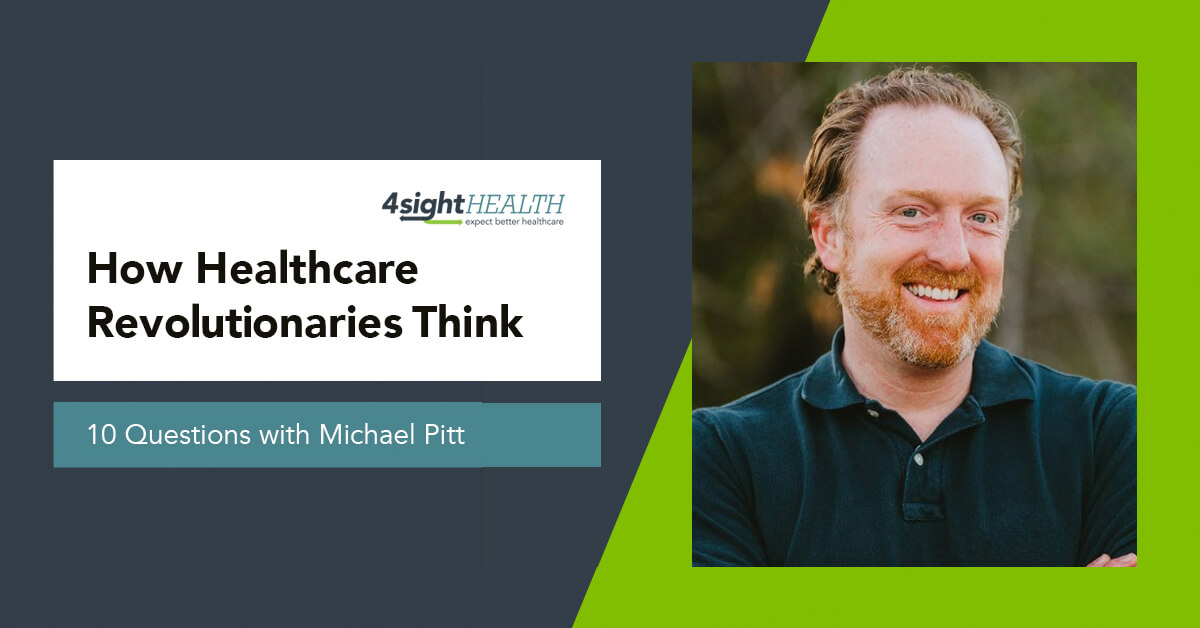May 2, 2023

How Healthcare Revolutionaries Think: 10 Questions with Michael Pitt, M.D.
Welcome to the latest installment of 4sight Health’s series, How Healthcare Revolutionaries Think. Our interview series profiles healthcare instigators who believe that outcomes matter, customers count and value rules.
Unless you like the food, being in the hospital stinks. It means you’re too sick or too injured to be home, and you need a multidisciplinary team of doctors, nurses and other medical professionals working 24/7 to make you better. It’s even worse for your family members, who anxiously wait at your bedside for the doctor to come in on rounds and update you on your condition. They wait. And they wait. Then they zip to the cafeteria to get some coffee, miss the doctor and have to ask you what the doctor said.
Sound familiar? That’s because it is. Every patient and every patient’s family experience it thousands of times a day at hospitals across the country. Ask anybody who has ever had a family member admitted to the hospital.
That’s the lousy patient experience that Michael Pitt, M.D., is trying to change with his Q-rounds app. The app syncs everyone involved in a rounding visit to a patient’s room — the patient, family members, doctors, nurses, interpreters, and even other clinicians — in a queue and tells everyone when that visit is next so they all can be there at the same time. It’s like taking a number at the deli counter and knowing how long it’s going to be before you can order your half a pound of shaved Krakus ham — but better.
I spoke with Dr. Pitt, who is a pediatrician affiliated with the University of Minnesota in Minneapolis, about medical education, innovation and what it will take to scale his idea for disrupting traditional morning rounds at a hospital.
You can also listen to a podcast interview with Dr. Pitt on his best magic trick, which is making the medical jargon that separates doctors and patients disappear.
1. Dr. Pitt, we always start by asking our interviewees to define a healthcare revolutionary. What’s your definition?
Pitt: I don’t have anything too exciting or too new to add to what others have said already. I’ll just say that healthcare is so different than any other space that exists. Simply saying that something works outside healthcare so we’ll bring it to our industry doesn’t work. You need a relentless pursuit of disruption and willingness to fight for change in a really, really slow beast where 50 people can say no before one person might say yes. When we think of revolutionaries and entrepreneurship, we think of great, new ideas. When I think of revolutionaries and entrepreneurship in healthcare, I think about the fighting that’s necessary. It’s a revolutionary war in which you have to commit to the battle to win as opposed to just having a good idea. A good idea is not enough.
2. Give me an example of someone who you think has a great idea and is committed to the battle in healthcare.
Pitt: Some of my colleagues at the University of Minnesota are healthcare revolutionaries. They’re trying to change the way we’ve taught medicine for the past 150 years through a program called Education in Pediatrics Across the Continuum, or EPAC. Emily Borman-Schoap, M.D., and Patricia Hobday, M.D., are the team leads of the program here. The medical education model that everyone knows is called “fixed time variable competency.” It assumes that after four years in medical school, you’re competent to be a doctor. But we know that after four years, medical school graduates are all over the place in terms of how ready they are to practice medicine in the real world. It’s like taking a cake out of the oven after a fixed time whether it’s done or not.
EPAC changes that model to “variable time competency.” If you’re competent to enter your residency at two years, you enter it after two years. If it takes five years, it takes five years. When EPAC deems one of our med students competent, he or she rolls right out of medical school and into a residency program to continue their training. The first time I heard about it, it really distressed me because that’s just not how it’s done. But it has turned out to be a pretty exciting innovation, and I’m proud to work with Drs. Borman-Schoap and Hobday as colleagues.
3. As a parent who has paid for two undergraduate degrees and is paying for a third, that sounds good to me. Do medical students who finish early pay less? If so, that can’t make the university happy. They are potentially losing out on medical school tuition payments for smart kids.
Pitt: That turned out not to be the economic barrier that we thought it would be. With EPAC, students pay for a degree no matter how short or how long it takes. It’s the same. And if someone leaves early because they demonstrated their competency, that opens up room for another tuition-paying student.
4. Speaking of undergraduate degrees, yours is in English and not biology or chemistry or a science that we typically associate with medicine. Why English? When I got my undergraduate degree in English, the usual career path was teach English, go to law school or run a bookstore — not be a doctor.
Pitt: From day one I knew I wanted to go into medicine and become a doctor. But I didn’t want to be a doctor because I loved biology, chemistry or medicine. I wanted to be a doctor because I love helping people through difficult seasons in their lives. That includes medicine, but more often it includes things like empathy and the ability to communicate effectively. I figured I’d lean into that in college and get all the science in medical school and in my residency program. I use the stuff from my speech-writing class all the time. And even the stuff from my two seminars on Mark Twain.
5. Were you on the speech team in high school?
Pitt: No, I wasn’t. I was too busy doing magic. I started doing magic when I was 8. I started doing it professionally four nights a week when I was 12. I used to say as a kid, “I’m going to be a magician and physician pediatrician when I grow up.” Early on I saw medicine as performance art. People say medicine is part art and part science. But most people don’t really dig into what they mean by the art of medicine. It’s not just about bedside manner. It’s performance art. The audience — the patient — has an expectation of what that performance should look like. There are standard, predictable lines, and there are improv moments when you have to react. I think having that skill set has made me a better doctor.
6. English major. Doctor. Magician. Where does the interest in pediatrics come from?
Pitt: Most people pick pediatrics because they love kids. They say, “I was a babysitter. I was a nanny. I have lots of brothers and sisters.” That wasn’t my reason. I don’t get gooey around kids. I sometimes say this sounds like I’m a sociopath, but I like sick kids. When a kid is sick, they display a level of resilience that you don’t see in a sick adult. It’s why I chose to work in the hospital. The kids inspire me. In pediatrics, as a physician, you usually have the ability to help them get better, which is not always the case with adults, and I want to repay their resilience. But I don’t do magic for kids. Kids think in magic. They have a shortcut in their brain that says magic. You can’t fool them because they have that shortcut. I actually much prefer doing magic for adults because they have rigid views that you could disrupt. But using magic with kids in the hospital is a powerful tool in misdirection and building trust.
7. Now there’s a segue. Who are you disrupting with Q-rounds and why are you disrupting them?
Pitt: What we’re trying to do with Q-rounds is level the playing field when it comes to doctors rounding to see their patients in the morning at the hospital. Level the playing field between patients and doctors, between doctors and other members of the multidisciplinary team, and between patients. No one is at a disadvantage when it comes to rounds. Everyone knows what’s going to happen, when it’s supposed to happen and who is supposed to be there.
If you’ve ever had a family member in the hospital, you know how frustrating rounds are. You get to the hospital at 5 o’clock in the morning and wait for the doctor to come because if you miss them, you’ve missed them for 24 hours. You can’t risk getting a cup of coffee or going to the bathroom or running to the giftshop or whatever. With Q-rounds, everyone who’s part of that round is in a real-time queue and knows whether a specific patient is eighth to be seen, sixth to be seen or next to be seen. The doctor is there. The nurse is there. The family is there. An interpreter is there. In the usual rounding model, the lack of time transparency is a pain point for everyone. I founded Q-rounds after sitting at the bedside for my father and then for my father-in-law waiting for the doctor to come or waiting at work for the doctor to call.
8. It sounds great. Like knowing when your table will be ready at a restaurant. It takes a lot of anxiety out of the situation. But I’m guessing someone doesn’t like it, at least initially, and that someone may be the doctor. Am I right?
Pitt: Yes. As a physician, I’ve always been the greatest skeptic of this idea even though it’s my idea and something I was creating. If we can’t make doctors’ lives better, no matter how noble the cause, it will be hard to do the change management necessary to make it happen. We really looked at addressing those pain points for doctors. The biggest one is time. We made it easy for doctors to drag and drop the list of the patients they’re going to see that day into the software in the morning and then hit start. That takes an average of about 41 seconds. In return, their rounds are more efficient, and they finish about half an hour faster. They’re not waiting for a nurse. They’re not waiting for the interpreter in person or online. They’re not waiting for a patient’s family. As a pediatrician, I can’t say to a 7-month-old whose parents aren’t there, “OK, tell your mom what we talked about.”
9. So once doctors start using it, they like it. They like the time transparency. They like the efficiency. They like not wasting time. Patients and their families like it. They’re less anxious about missing the doctor on rounds. What about the hospital? The hospital would be the one paying for this, right?
Pitt: We recognize, cynically or not, that I have to convince hospitals that this is something they should implement. That’s the hardest part. No matter how much of an aha moment Q-rounds creates — or how much common sense it makes — it has got to affect the bottom line in a positive way. We’ve come to accept that. We’re studying how it gets nurses to the bedside, how beds turn over faster, how there are fewer medical errors when you have the whole team in a patient’s room and how it improves patient satisfaction scores. That’s what I mean by revolutionary. We’re fighting that war to prove the business case.
10. You moved to Minneapolis from Chicago in 2013, so you’ve lived in Minnesota for about 10 years. What cultural mannerisms have your learned or have had to adapt to?
Pitt: Minnesota is a very rule-following state. It has the highest voter turnout every year. Not because of civic pride or anything like that. It’s because you’re supposed to vote, so you vote. If you’re driving on an interstate in Minnesota and your exit is two miles away you’ll be in the right lane for two miles because that’s what you think you should do.
Minnesota’s reputation for being passive-aggressive is true. I’ll give you an example. When we say, “Feel free,” as in, “Feel free to stop by,” or “Feel free to drop it off,” we mean it’s optional. You have a choice to stop by or drop it off with no repercussions either way. In Minnesota, “Feel free” is a command. Here, when someone says, “Feel free to turn that in tomorrow,” it means it’s due tomorrow at 9 a.m. sharp, and it better be on my desk. It’s taken me time to adjust to the language. I catch myself being passive-aggressive sometimes, and I have to stop and correct myself. I can’t go to the dark side.
Burda’s Final Bit
I’ve been an inpatient at a hospital and a family member of an inpatient at a hospital. In each case, you’re desperately waiting for information from your care team about whether the patient is going to live or die, get better or get worse, or if they can go home or have to stay longer. If Dr. Pitt’s app can make the waiting less anxious by letting you know when to expect that information, I’m all for it. Urgent care centers tell you their wait time. Hospitals post their emergency department wait times on billboards. Why not tell inpatients when to expect the doctor? It’s not magic.
Dr. Michael Pitt is a graduate from the Johns Hopkins University School of Medicine. He completed his residency in pediatrics at Northwestern University’s Children’s Memorial Hospital in Chicago. Dr. Pitt believes that a good pediatrician must be a good educator and enjoys equipping medical students and residents with tools that improve bedside teaching, patient rapport, and parents’ understanding of complex diseases in their children. He is an associate program director for the University of Minnesota Pediatric Residency. An award-winning magician who has performed internationally since the age of 8, Dr. Pitt leads workshops for pediatricians on how to incorporate magic into the physical exam to ease anxiety, build rapport, and increase diagnostic yield.
Q-rounds is a real-time, virtual queue that patients, families, and providers can access while in the hospital so everyone knows when to expect rounds. Get informed, stay informed. Have more certainty in your daily schedule, and virtually join rounds from anywhere.
Read more Healthcare Revolutionary interviews
- April 2023: Rebeckah Orton
- February 2023: Dan Trigub
- January 2023: Melina Davis
- December 2022: Bruce Brandes
- November 2022: Lena Chaihorsky
- See the full series here.





